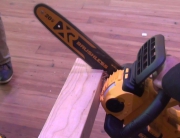The See Jane Drill Tool Buying Guide: Power Drills
Your power drill will be the workhorse of your tool box. The drill is probably the first power tool that you will purchase as a new DIY-er, and it will be the one you will use most often for your do-it-yourself projects. There are many types of drills on the market, and it can sometimes be overwhelming when you are attempting to select the best drill for your needs. How much power do you really need? Should you go with a cordless or corded drill?
Here is our at-a-glance checklist for purchasing a power drill:
Checklist for Purchasing a Drill:
- Feels comfortable in the hand
- Power: 18-20 volts (cordless only)
- Has variable speed settings
- 3/8 to 1/2 inch drill (chuck) size
- Keyless chuck, preferably
- Lithium ion type battery (cordless only)
- Reversible feature
Let’s now discuss each of the above items in detail:
Comfort:
The tool should feel well-balanced and comfortable in your hand. Try to imagine what it will feel like after a few hours of use. You will want to make sure the controls are convenient, and all switches are easy to use.
The T-handle style is commonly found on cordless models, and it is ergonomically sound, as the handle is in the middle and the weight is distributed evenly, which reduces the impact on your wrist. The pistol-grip style is preferred by some people, however, and it is commonly found on corded drills.
Power
Cordless drills’ power is measured in volts. Higher voltage means heavier weight. If you are only going to have one drill, it should be a minimum of 18-20 volts. That is enough to handle just about any home improvement task that you might encounter. However, down the line, if you want to supplement your tool box with an additional drill, you may want to consider a 12-volt for light duty around the house.
Corded drills are measured in amps. Generally, a higher amperage motor means the drill has more power.
Drill Speed
Different materials require you to set the drill at different speeds. You will want to purchase a drill with a variable speed. Variable speed means that the user controls the bit speed, which is useful when you plan on working with different materials and accessories.
The Chuck
The chuck is the part of the drill where the bit is inserted. Chuck measurements, also sometimes called the drill size, come in 1/4-inch, 3/8-inch and 1/2-inch sizes. For most DIY projects, a 3/8-inch size should be sufficient, however, a ½-inch size would be even better.
Chucks come in both keyed and keyless versions. Keyed is where the jaws are tightened or loosened with a key, and keyless means the chuck can be tightened or loosened by hand. The benefit of a keyless chuck is the ease in which bits can be changed effortlessly and quickly. Another thing to consider is that a drill with a chuck key means that the key is separate from the drill and can easily become lost. In most cases, See Jane Drill recommends the keyless chuck option for its ease of operation.
Cordless Drill Batteries
Battery types are generally either nickel cadmium or lithium ion. Lithium ion batteries are lighter and smaller. It is for this reason that See Jane Drill recommends lithium ion battery powered drills, because they are much lighter and smaller and more comfortable to hold.
The standard time required to charge a battery pack varies, depending on the type of tool and charger. It is a good idea to have an additional battery on hand, because run-times also vary and if you are involved in a longer home project, you certainly don’t want to have to stop working and wait while your battery recharges.
Corded drills however, don’t depend on batteries for power. They are well-suited for tough jobs because they have a constant supply of electricity. However, this of course requires having a power source nearby.
Other Drill Features to Consider
A reversible drill is a must-have, especially if you plan on using the drill with screwdriver bits
Added drill features such as built in LED lights and levels are nice to have, though not absolutely necessary. For heavier DIY projects, such as mixing mortar, side handles provide more stability and control.
Accessories for drills include bits for drilling every possible surface, as well as hole saws, screwdriver bits, rasps, sanding disks, paint and mortar paddles.
There are drills which offer the latest in motor technology, which includes brushless motors. These types of tools are controlled via microprocessor chips, resulting in tools which tend to be quieter, more powerful and lighter. They tend to be pricey, however.
Most importantly, choose a drill that you feel comfortable using! Nowadays, there are drills available in just about every price range, and you are certain to find the right one for you.
by See Jane Drill, Copyright 2016, All Rights Reserved






This is a very good guide for beginners. Thanks for this.
Great guide – and great explanation about chucks!
This mentioned a few factors I wouldn’t have thought to check. Comfort level, in the long run, would be massively important. I’m trying to put together the perfect tool kit for my husband who loves creating or fixing things for fun in our garage.